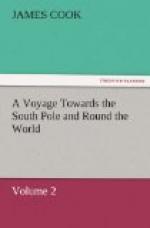When the boats returned, Mr Cooper informed me, that they had landed on the beach which is at the head of the bay, near a fine river, or stream of fresh water, so large and deep that they judged boats might enter it at high water. They found three fathoms depth close to the beach, and fifty-five and fifty, two cables’ length off. Farther out they did not sound; and where we were with the ship, we had no soundings with a hundred and seventy fathoms line. Before the boats got on board, the wind had shifted to the S.S.E. As we were in want of nothing, and had no time to spare, I took the advantage of this shift of wind, and steered down the bay. During the fore-part of the night, the country was illuminated with fires, from the sea-shore to the summits of the mountains; but this was only on the west side of the shore. I cannot pretend to say what was the occasion of these fires, but have no idea of their being on our account. Probably, they were burning or clearing the ground for new plantations. At day-break on the 27th, we found ourselves two-thirds down the bay, and, as we had but little wind, it was noon before we were the length of the N.W. point, which at this time bore N. 82 deg. W., distant five miles. Latitude observed 14 deg. 39’ 30”.
Some of our gentlemen were doubtful of this being the bay of St Philip and St Jago, as there was no place which they thought could mean the port of Vera Cruz. For my part I found general points to agree so well with Quiros’s description, that I had not the least doubt about it. As to what he calls the Port of Vera Cruz, I understand that to be the anchorage at the head of the bay, which in some places may extend farther off than where our boats landed. There is nothing in his account of the port which contradicts this supposition*. It was but natural for his people to give a name to the place, independent of so large a bay, where they lay so long at anchor. A port is a vague term, like many others in geography, and has been very often applied to places far less sheltered than this.
[See Quiros’s Voyage, in Dalrymple’s Collection, vol i, p.136, 137.]
Our officers observed that grass and other plants grew on the beach close to high water-mark, which is always a sure sign of pacific anchorage, and an undeniable proof that there never is a great surf on the shore. They judged that the tide rose about four or five feet, and that boats and such craft might, at high-water, enter the river, which seemed to be pretty deep and broad within; so that this, probably, is one of those mentioned by Quiros; and if we were not deceived, we saw the other.




